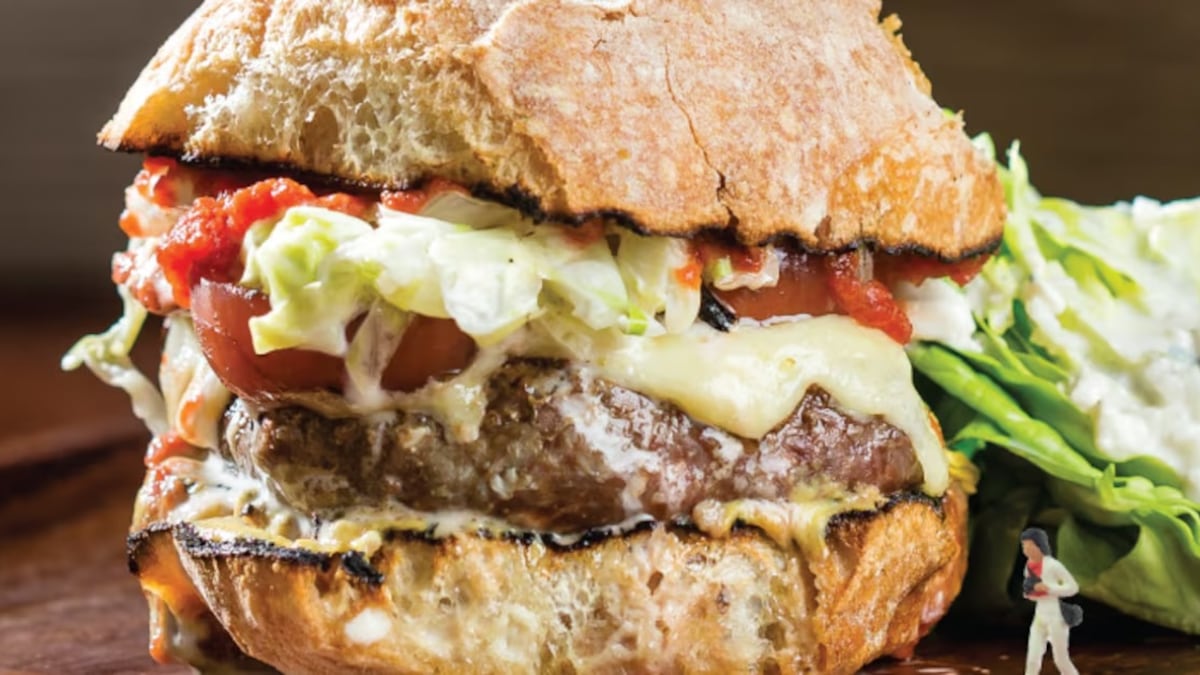This story first appeared in the Oct. 28, 2015 edition of WW. We have updated it to note which restaurants have since closed.
This week, we release our annual Restaurant Guide—look for it in select blue boxes, plus restaurants, bars and Powell’s Books—which captures everything we love about the 99 best restaurants in town and names Portland’s 2015 Restaurant of the Year.
But this story is not about the Restaurant of the Year. It’s not about what’s new. In a certain way, it’s not even about restaurants.
It’s about the dishes that make a vital restaurant scene like Portland’s possible.
The simple Thai chicken and rice dish that spread from a humble downtown food cart to fuel TV appearances, TED Talks and a burgeoning Portland empire.
A fast-food-inspired burger at a French restaurant that’s routinely ranked as one of the top in the nation.
A humble homestyle casserole elevated to refined comfort at what may very well be the best Russian eatery in the country.
While anyone can capitalize on so-hot-right-now trends, only the very best chefs can truly create an icon, a plate of food that endures for years as a symbol of what good food can be.
Over time, their reputation spreads to the Japanese tourists lining up joyfully on the sidewalk for chicken and waffles, or chefs from Iceland who return to their homeland raving about those crazy fish sauce wings.
Chances are, you’ve tried many of these dishes. But we asked the people behind the 12 most iconic Portland dishes of the past decade to tell us the stories behind the food we love: the moments of inspiration, the thought behind each ingredient, and the lucky accidents.
Here are the origins of the 12 wonders of Portland food.
The Le Pigeon Burger, at Le Pigeon
738 E Burnside St., 546-8796, lepigeon.com.
The cheeseburger at East Burnside’s cramped, clubby Le Pigeon became a cult favorite in part because of chef Gabe Rucker’s original practice of limiting the number served in a night to five. “It was never a hard limit,” he says. “But after we stopped limiting the number, we actually sold fewer burgers.” At a restaurant known for beef bourguignon, duck blanquette and dry sherry, it’s odd to see a $14 burger and a $3 bottle of Coors Banquet.
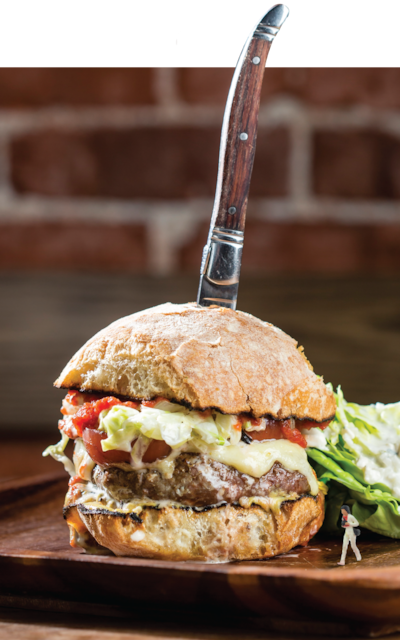
But that burger’s success proved wildly influential. Since Le Pigeon’s legendary burger debuted in 2006, it’s rare to find high-end Portland restaurants that don’t offer a bistro burger and a tallboy—a quirk to this town.
As told by Rucker…
“My first day at the restaurant, I was trying to get my head screwed on straight. I was just spitting out ingredients, and somebody wrote them down.
I said, ‘We need a burger, and we’re going to play off fast food.’ I said, ‘We’re going to make the patty square like Wendy’s.’ I think Jack in the Box was pushing ciabatta at the time. We used extra-sharp white cheddar from Tillamook, and I love onions on a burger, which stems from eating at In-N-Out a lot—we grill and pickle them so you get the best of both worlds.
And I like iceberg lettuce, which I use as a delivery vehicle for the housemade aioli. It distributes it. The thing I hate is when there are globs of mayonnaise. The Dijon is a spicy Dijon, and for the housemade ketchup I spit out a list of ingredients, we made it, and it’s been our ketchup ever since.
Nine years later, newspapers are still calling me about that burger. To be a good chef, you need a lot of luck. Some things you have to abandon, but this came out as a perfect storm."
The Coppa Steak at Toro Bravo
120 NE Russell St., CLOSED in 2020.
John Gorham invented the coppa steak.
Well, the restaurateur didn’t invent cows, cold-smoking or dry-aging. But his technique was the secret formula for turning a forgotten cut into a perfect hunk of meat on a tight budget.
Like so many great, meaty innovations, it was born of tough times—in this case, the Bush recession—and through days of work it becomes a tender hunk. Then it’s just a matter of giving it crispy edges and a topping of spicy-creamy salbitxada, a Catalan sauce made of almond, garlic and chilies. In 2007, when we named Toro Bravo the Restaurant of the Year, we called it “at least as satisfying—and far more interesting—than many steakhouse cuts at triple the price.”
As told by Gorham…
“When you’re in Spain, there are a lot of big chunks of beef everywhere. We wanted that, but we wanted to keep our prices low at Toro—we opened in 2008, right after the market crash, but we wanted something that would give you that feeling of having a nice steak.
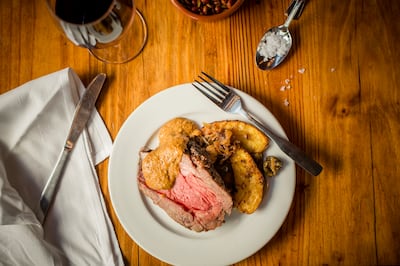
So I came across chuck-eye roast. It comes from right at the top of the neck—in pork, it would the coppa. It’s not an expensive cut. And I started thinking, ‘How can I break this piece of meat down and give it big flavor?’ We experimented with it—cleaning it and trussing it and then open-air aging with a salt cure.
We put it in salt and pepper and open-air age in the walk-in for five days. That’s dry-aging. We cold-smoke it for a couple hours and we plastic-wrap it right then and put it back in the cooler—that’s wet-aging. What that does is really start to break down the tissue.
The salt and the pepper get in there—those are the only seasonings, salt, pepper and smoke—and the salt allows us to really get that crazy crust on the outside when we sear it. After we cook it, we let it rest, always, for a half-hour. No matter how busy we are, we let it rest for a half-hour before we serve it.
It’s those secondary cuts when you see the chops of a real chef and cook. We can all cook a tenderloin really well. What can you do with a cheaper, tougher piece of meat?"
Ike’s Wings at Pok Pok
3226 SE Division St., CLOSED in 2020.
Andy Ricker began Pok Pok as a little chicken shack on an unauspicious plot of land on Southeast Division. It went from service-industry secret to nationwide phenomenon in just a few years.
That charcoal-grilled chicken, learned in Thailand, may have inspired Ricker to start the restaurant. But the wings that turned Pok Pok into an icon came not from Thailand but from a dish Ricker had in Hanoi in 2004, with a helping hand from Ricker’s very first employee, Ich “Ike” Truong. Ricker’s wings were coming out too salty, so he asked Ike if he knew how to make Vietnamese fish sauce wings.
John Kennedy was Ricker’s lead line cook from 2006 to 2008, as the wings were introduced—at the time, he says, he held the house record for making the most wings in a night, at more than 800.
As told by Ricker and Kennedy…
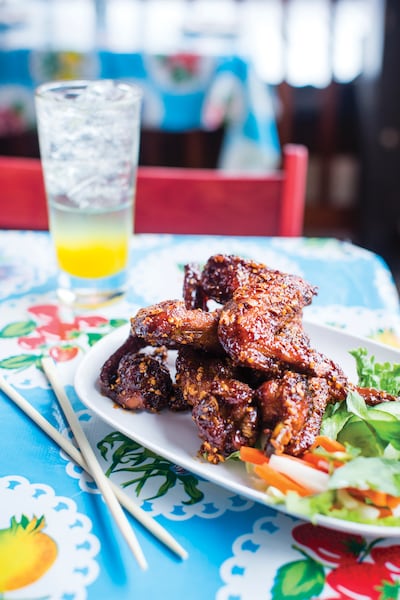
RICKER: Ike’s Vietnamese Fish Sauce Wings came from a dish I had in Hanoi back in 2004 or so on a backpacking trip at a bia hoi stand, called ga chien nuoc mam (fish sauce wings). You can find a version of them at a lot of Vietnamese restaurants in the U.S.A. When the main restaurant opened, they were one of the first things I wanted to be on the menu. I was fucking around with the recipe, and they were not coming out right: too salty. So I asked Ike, Ich Truong, who was my first employee…if he knew how to make them. He said “yeah, man” and asked me to give him 2 pounds of wings. The piece of the puzzle I was missing was the addition of garlic water to the marinade recipe and a bit more sugar than I was using, and suddenly the flavor came out correct. He also told me to glaze them with the same stuff we marinate them in and to add some chili paste to the glaze if I wanted them spicier. That was the extent of Ike’s involvement with the development of the recipe—just that one hour, one afternoon, but it was invaluable, and it is the reason we named them after him.
KENNEDY: There was a good four to five months that Pok Pok was dead. When we experienced the media boom, everybody was behind the eight ball. We went from doing 50 covers a night to doing 300 covers a night. Wings will also steam themselves on the plate, so they’re not going to be crispy. This was before we had runners and servers with ear monitors. We just had two walkie-talkies.
RICKER: We had the recipe down, we were just having issues with execution on the line. [Kennedy] provided a key to the process, which was to squirt a small amount of water into the pan at the end. This happened fairly soon after we started developing the recipe.
KENNEDY: What makes the wings work is the double frying. It goes straight from the fryer to wok with fish sauce, palm sugar, fried garlic—and if it’s spicy wings, bird pepper chili paste. A few tosses in the wok and you’re basically candying it. The Chinese have been doing it for eons…. After Ike’s fish sauce wings gained in popularity, people started to wonder: These wings are by far the most popular item. What’s Ike getting out of all this? One day he did show up driving a gold Lexus.
RICKER: Ike has always been credited for his contribution to the recipe, which was the process of adding water to the garlic and squeezing the juice out instead of using whole garlic, and a couple other minor adjustments. He supplied the key ingredient to getting the recipe on the right track, and he has been compensated for that and will continue to be compensated. He does drive a Lexus from Pok Pok and other jobs he’s held, but I don’t think it’s gold.
Herring Under a Fur Coat at Kachka
960 SE 11th Ave., 235-0059, kachkapdx.com.
Kachka chef Bonnie Morales was once embarrassed by the Russian food she grew up eating: the pickled fish and pink-topped casseroles served next to bottles of vodka.
But after a dinner at her mother’s house, Morales’ future husband and Kachka partner, Israel, was enthralled with both the food and culture, and Morales changed her mind about the worth of her humble home foods.
At Kachka, which opened in 2014 and is now widely considered one of our nation’s best Russian restaurants, Morales’ pelmeni dumplings and beef-tongue stroganoff are wonders of richness, texture and savory satisfaction. But the most striking dish—the one everyone comes home talking about—is also the most humble, a pink-topped salad called herring under a fur coat, served in the shape of a lovely rainbow-layered galette of fish and vegetable. It looks like nothing else on earth, and it tastes like pure comfort.
As told by Morales…

“When you think of Russian food from the Soviet era, there are a handful of dishes. This is one of them. It’s something my mother had at parties, something I’d grown up around. Growing up, I found it horrifying—I wouldn’t touch it with a 10-foot pole. I don’t think I ever tried it myself until Israel and I were dating, and he thought it was so good.
It’s really interesting when you think about it. There are all these soft flavors. Usually you want there to be a variety of textures, but there are exceptions. The unctuousness builds on itself until it becomes decadent. The differences are very minor on our dish to what my mother does: Herring is normally its own layer, but we instead make a marinade and dice it up with sweet onion and dill and oil to integrate the flavor into the herring.
And we make our own mayonnaise, which is something most home cooks never do. Part of making herring under a fur coat is, you put plain old mayo on top, and the mayo turns pink. It tastes better fresh, so we mix the beets in with the mayonnaise. It’s a little bit of a trick to make it look like it sat a little bit. That pink can be very striking in small quantities."
Clam Chowder at Ox
2225 NE Martin Luther King Jr. Blvd., 284-3366, oxpdx.com. Reopened this week after 2024 fire.
Until recently, our port town’s seafood didn’t stray much from the trout and salmon caught in nearby rivers. Even with the coast just two hours away, oyster options didn’t go much farther afield than Dan & Louis or Jake’s, and other than a pilgrimage to Mo’s at the coast, Portland had no clam chowder tradition to speak of.
Well, Ox built Portland’s chowder scene single-handedly in 2012, with a bowl spiced with jalapeño and fortified with bone marrow. It became instantly famous in town as soon as it arrived. It’s a long, contented sigh of umami with bright and salty spice, infused with the delicacy of fresh clams still in their shells.
As told by chef Greg Denton…
“This version of my clam chowder I started to develop at a restaurant when I was in Napa Valley—the chef Hiro Sone put me in charge of certain things, and soup was one. Then I brought it to Metrovino, and it became seafood chowder to be able to use fish scraps. But we made it with flour, so it was really heavy—it was hard to eat anything after it.
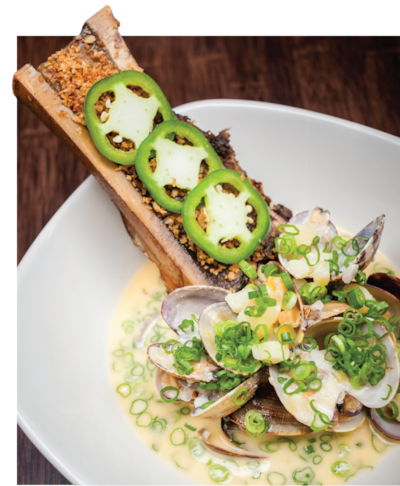
When I left Metrovino, there were certain recipes the owner wanted to keep. So I said, ‘I’ll make a better chowder.’ I started by thinking, what were the negatives of that chowder? The heaviness. By removing the flour, we made it lighter, even though it’s still milk and cream. That milky broth allows us to open up clams inside that chowder, so there’s a fresh burst of seafood flavor. And they’re freshly opened, which makes everything better.
So we had this chowder—and we needed something to replace that floury richness. We thought, hey, let’s throw a canoe-cut marrow bone in there. We’ll smoke it first, and then we’ll warm it up and put that on top. You have fattiness you’d get from bacon, and smokiness you’d get from bacon. And then there’s still bacon in there.
To balance this thing with fat and smoke and fat and smoke, you have to balance it with something extreme. That’s where the raw, sliced jalapeño came in. By adding fresh-cut spring onions and parsley with jalapeños, it balances it.
When we were opening the restaurant, we were so tired, working so many hours, up until 4 am. I got the first taste, and it was an emotional response. I can’t tell you what emotion—fear, anxiety, happiness and sadness all mixed together. I knew right away it would be a special dish.
Now we sell more chowders on the hottest days of the year than the coldest days. I don’t know why. But we sell it all year-round. We had a gentleman, he’d come in and order two chowders and get a skirt steak. Then he’d get a chowder to go."
Crispy Pig’s Ear at Aviary
1733 NE Alberta St., CLOSED in 2020.
New York chefs Sarah Pliner, Jasper Shen and Kat Whitehead came to Portland to follow their dream of starting a restaurant, all moving into the same house to plan their menu. The restaurant they finally built, Aviary, was a wonder of imaginative ingredients marrying European techniques and Asian influences. It promptly burned to the ground because of an errant firework on the Fourth of July.
But they rebuilt within the year, becoming our 2012 Restaurant of the Year in part on the strength of a dish made with the same pig’s ears you give your dog to chew. The crispy pig’s ear bowl is a hybrid beast: a concoction of refined and balanced herbal notes in a dish as salty, savory and fun as a bag of chips at the Super Bowl. But they’d first conceived their trademark dish out of desperation, when they were tired of everything else.
As told by Pliner...
“When we first moved here from New York, Jasper and Kat were living with me. We were trying to talk about what the restaurant would be and working on dishes, and really had a week of cooking nothing we were happy with.
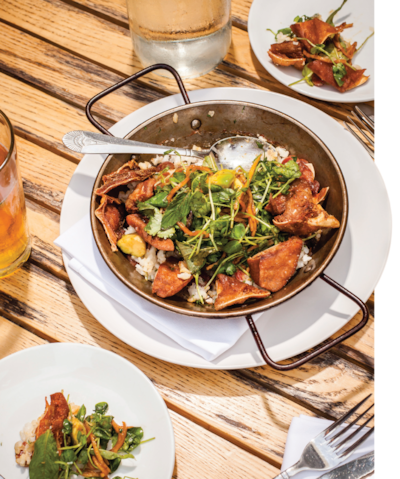
We were tired of eating really complicated food. We just decided to make some leftovers and rice. What we made that day was steamed rice and a bunch of herbs and daikon with black vinegar and avocado, and that was it.
Thai basil and cilantro, and tiato—it’s a type of shiso—and rau ram (Vietnamese coriander), which is shaped like mint but it’s a rounder leaf with some fishy things going on. But it was really good, even missing a lot of the elements we ended up with. One of us said, ‘This should be a dish at our restaurant.’
I took it from there and added pig’s ear and coconut rice Chinese sausage to finish it. I felt like it was a pretty satisfying dish as it was, without any proteins, but if you’re trying to get a menu together, it needs to be more than what you eat at home. I didn’t want to do a really fatty protein—pig’s ears are fatty the way that potato chips are, they don’t sit in you like a brick.
Especially in the beginning, we were trying to be a less expensive restaurant, so I was working really hard to find things that were cheap but good that we could get out there at our price. Something fun that would function like a protein but be less serious to eat, and also be interesting. We wanted a menu that people would talk about.”
Fried Kale at Smallwares
4605 NE Fremont St., CLOSED in 2019.
David Chang is probably best-known to food-obsessive Portlanders for palling around with Anthony Bourdain in Japan on TV and founding McSweeney’s food porn mag Lucky Peach.
But his New York-based Momofuku chain of restaurants has cast a long shadow in Portland, from those once-ubiquitous steamed pork buns to alums like the Stray Dogs chefs Peter Cho and Johnny Leach, Double Dragon owner Rob Walls and, of course, Smallwares’ chef-owner Johanna Ware, whose bowl of fried kale, candied bacon, mint and fish sauce remains the hallmark of this Beaumont neighborhood “inauthentic Asian” restaurant.
The dish is both deceptively simple and startlingly singular, and it finds its origins back East.
As told by Ware…
“It came about from a classic Momofuku dish I made when I was working [at the famous New York restaurant]. They’d just opened Ssäm Bar, and they had fried Brussels sprouts with fish sauce vinaigrette. I didn’t want to replicate it, but I was influenced by it.
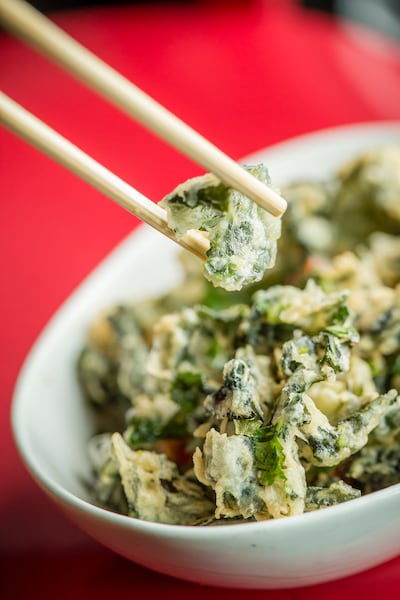
If you talk to most chefs who were working at Momofuku at that time,they would probably have had a dish with similar elements on their own menu at one time or another.
We actually started with butternut squash. But I hate butternut squash. So when spring came around, I tried different greens. I thought, ‘I’ve never fried kale.’ When you have a fryer, you just kind of want to put things in it. I didn’t really think it was going to work.
It was kind of hard to figure out. You want the leaves to be big. You get the leaves in flat—you can’t put in a massive pile. It takes time. On Friday and Saturday, we have one extra person on kale duty.
The fish sauce vinaigrette is cut with lime water, sugar, chilies and garlic, then chopped-up cilantro and mint. I love bacon and wanted something smoky and fatty in there. The bacon is candied, and it’s a very smoky bacon. I thought the smoke and fat and sugar would go well with the saltiness of everything.
When we teach our new cooks, we let them know this is the one dish they have to nail. I definitely didn’t expect it to become our signature dish."
Nong’s Khao Man Gai
Multiple locations, including 609 SE Ankeny St., Suite C, 740-2907, khaomangai.com.
Nong Poonsukwattana knew Portland didn’t need another typical Thai restaurant. That was obvious when she arrived on the heels of her now-ex-husband, who attended Portland State.
After a year working at Pok Pok, she got an idea. She bought a food cart just ahead of full-blown cartmania and started working on making the perfect chicken and rice.
The eponymous dish at Nong’s is still the main offering, six years and several offshoots later. You need nothing else: tender chicken served on a bed of rice with soybean sauce and a little palate-cleansing soup. It’s sticky, rich, beautiful and perfect, exploding with ginger and chili and garlic. It is, Poonsukwattana says, exactly what she would serve to her friends or family.
As told by Poonsukwattana…
“I came to America with the dream that I would have a better life. With the cart, I started everything from scratch. The idea was just to create something for myself, a future for myself, with no man, just one woman. I want to make a living making things with my hands that I’m proud of.
What I learned from working at Pok Pok is that there are 500 Thai restaurants in Portland and I had to make something different. Where I’m coming from, you can do just one thing—a whole family makes one thing very well and passes the knowledge to the next generation. At the market, there would be like 500 other vendors who would compete, so you would have to be good.
I just make chicken and rice like it’s supposed to be, and that’s what I know. There are four parts of the dish: rice, chicken, sauce and soup. The hardest part of the dish is rice. If you try to train 10 people to make rice, there will be only one person who can make it.
With each ingredient, I got the best. With soy sauce, it’s like tequila—you can buy $15 tequila or you can buy $70 tequila. I chose the one that’s the best. In this process, everything came down to a choice I’d make, and I wanted to pick the best one.
When I started, it was hard. When I opened one day, I worked all day and only made $40. I was crying. I asked myself if I was happy. And the answer was yes, I was proud of what I made."
Screen Door
2337 E Burnside St., 542-0880, screendoorrestaurant.com.
Fried chicken and waffles are a salty, sweet soul-food tradition from the Southern diaspora—depending on who you believe, originating at either a 1930s speakeasy in Harlem or a 1940s soul spot in Los Angeles. But over the past 10 years, standing in an hour-plus line to eat Screen Door’s towering plate of fried chicken on a sweet potato waffle has also become a hallowed tradition, so popular that the restaurant is under constant pressure to come up with specials that compete with the chicken.
As told by co-owner Nicole Mouton…
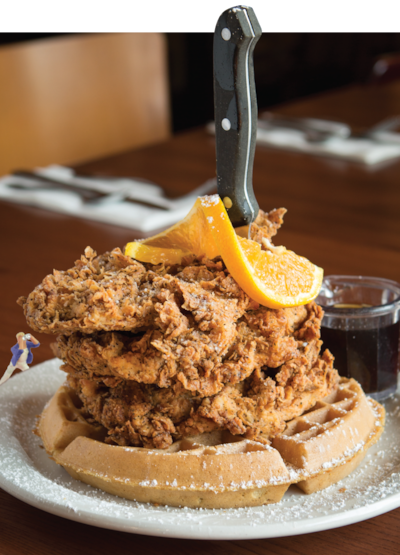
“When we first opened, we didn’t really know what to expect. It was a totally different restaurant scene. Clarklewis was in its heyday, and they wanted to kill the restaurant and re-create the restaurant. We said, ‘Let’s find a place where you can bring everybody and everybody feels at home.’
The thing we’re most proud of is, we have the most diverse dining room in the city, hands down. All kinds of people come to our restaurant, and that makes me happy.
We didn’t have the fried chicken and waffle on the menu originally, and we had customers asking about it. We started playing around with different versions.
A lot of times with fried chicken, they try to put in a bunch of secret-recipe spices. We felt like keeping it simple was best. We decided to go with boneless because brunch is fast-paced. We didn’t want people to worry about chicken on the bone.
We went with a sweet potato waffle to give it a unique touch that we could call our own. It has some flavor in common with pie spice, but there’s also some molasses. It works with fried chicken.
We just started loading chicken, and we got to a pound-plus of food. People just couldn’t believe it. It was jaw-dropping to see that much food on one plate.
When we first started, it was more than we could handle. It was a learning curve. We had no idea when we put fried chicken on the menu it would outpace everything else.
It sort of creates a competition in the kitchen, within the menu itself. You can’t have a kitchen where you get all the food coming off one station. We serve 500 plates in a brunch. What fantastic thing can we create that will lure people off the fried chicken? It’s a challenge. We don’t ever beat it, but we come close.
It tastes really damn good. Ten years later, you’ll still catch me, the owner, sitting down to a plate of chicken and waffle."
Pork Belly Cubano at Bunk Sandwiches
621 SE Morrison St. and other locations, 328-2865, bunksandwiches.com.
Tommy Habetz started his chef’s career cooking in the restaurants of seemingly every celebrity chef in America, from Bobby Flay to Mario Batali to culinary tycoon Drew Nieporent. But his tastes ran a lot simpler. He wanted to run a sandwich shop, making the humble flavors he fell in love with starting when he was a kid eating at McDonald’s.
Bunk’s pork belly Cubano hit Portland’s food scene like a protein bomb, sending lunchtime lines sprawling out onto the sidewalks of a then-desolate stretch of Southeast Morrison. It’s a classic Cuban updated with a fine smoked ham and a healthy slab of fatty, lovely pork belly, and when it is perfect, it is truly perfect.
As told by Habetz…
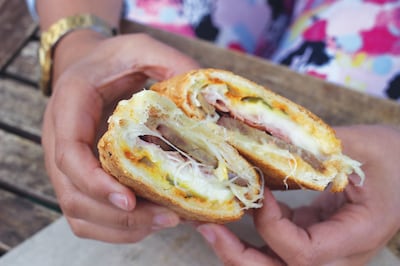
“The pork belly Cubano first came about when I worked in Boca Raton, Fla., for a year in 2000 opening a resort. Florida, especially at that time, is the desert of morals and the desert of food. Cuban food was where it’s at. The first time I had a Cubano sandwich I was obsessed. It’s a perfect sandwich. The combination of flavors is similar to a McDonald’s cheeseburger. When I was a kid, a McDonald’s cheeseburger was the most delicious thing—I was not raised on foie gras.
Move forward to 2008, we’re starting Bunk, and I said, ‘We gotta do a Cubano.’
One of the great things about being an American chef, and a Portland chef specifically, is you’ve got a lot of freedom. There’s a blank slate. Sometimes that results in horrible abominations with too many alfalfa sprouts, but it lets you stand back, look at something and see every element to make an improvement.
The sandwich is great, but the ham and the pork loin are always the weak elements. We have a great smoked ham from Eastern Oregon—otherwise it’s usually just a boiled ham. And at the time, pork belly was kind of an unusual thing. We took a chance by making it pork belly—some people find it too fatty. Now we make a roast out of the shoulder and the belly, so you get some of the meatiness of the shoulder. We do a cure on it, and then slow roast it with molasses.
We wanted to use a really good yellow mustard, and adding mayonnaise is kind of a personal thing. Some people are traditionalists. But the mayo and the swiss cheese, when we put it into a press and put it in an oven, it creates a whole other thing. It makes a great sauce. We add Valentina hot sauce, which tastes like Cholula at a fraction of the cost.
The Cubano was featured on Diners, Drive-Ins and Dives within the first 12 months of being open, even though we were neither a diner, drive-in or dive. Chris Cosentino picked it on The Best Thing I Ever Ate. And now everyone gets the Cubano."
Cornbread Madeleine, at Holdfast Dining
Fausse Piste Winery, 537 SE Ash St., CLOSED in 2020.
Part of the fun of going out to a hot new restaurant is comparing notes with others who have been. Sadly, most of the pop-up dinner series that have captured the imagination of local foodies don’t offer that—the array of dishes is dizzying, and the menus change nightly.
But anyone who’s dropped $90 (not including gratuity) for a nine-course prix fixe meal at Holdfast has one dish in common. That dish is the youngest and sweetest icon on this list, a cornbread madeleine tucked between the savory and dessert courses to brilliant effect.
It was developed by chef Will Preisch during a European odyssey that followed his time as the head chef at the Bent Brick. Under his watch, the restaurant was adventurously modern. It just never gelled with the space.
Following Preisch’s departure, publications like The Oregonian and Portland Monthly filed obituaries for his Portland cooking career (“it takes some major cojones for a restaurateur to admit defeat,” wrote Portland Monthly; “where’s the burger?” asked The Oregonian) but quickly hailed his second coming, which finds Preisch and fellow Bent Brick alum Joel Stocks doing everything inside Southeast’s dim Fausse Piste urban winery.
As told by Preisch…
“When I left the Bent Brick it was my decision, but obviously I was not having the success I wanted to have there. After I left, I wanted to continue my culinary education. I’m a rather proud culinary school dropout, but I was in a journeyman phase.
I had already been at the Bent Brick and spent a lot of time thinking about what went right and what went wrong. A lot of our food now isn’t super-different—it’s all about packaging and timing. The city wasn’t ready for it, and it was on a macro scale at the Bent Brick. And certainly everything we do is a little more dialed in now. The technique we use isn’t super-different, but the food itself is a lot more simple and with the tasting-menu format the food can be more focused.
I came up with that dish in Copenhagen. I was staging at the restaurant Relæ. And at Relæ, when it’s your last day in the kitchen, you make a staff meal. I wanted to do something really American that they wouldn’t have had before, so I came up with the idea of cornbread and chili, so I made cornbread with honey butter.
They freaked out about the cornbread. That’s the same cornbread the madeleine is made of. As an American, it was tough to explain that though this bread is really sweet, it’s not a dessert.
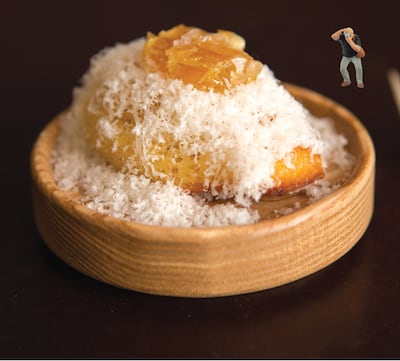
It just kinda spiraled as I thought about it. We deconstructed it: cornbread toasted in the oven during service. Once it’s crispy, we brush it with brown butter five times, after that we put a layer of lardo and then the honeycomb on top with some salt. I was inspired to cover it in Parmesan cheese by Relæ as well; they had a snack on called the ‘Kornly cracker’ that was shrouded in so much cheese it was all you could see.
It was on the first Holdfast weekend dinners. I really liked the cornbread madeleine, but I didn’t intend to keep it around for every meal.
But it got requested for a photo shoot the following weekend, for Portland Monthly. We ran it again the next weekend. We got another request for it to be in a photo. I thought, ‘We’ve already served it at the first four dinners, maybe we should just keep it around?’ It bridges the gap between savory and sweet in a really awesome way.
So it’s stuck around—it’s the only thing that’s been on every menu we’ve done."
Sausage and Mama Lil’s Pizza at Apizza Scholls
4741 SE Hawthorne Blvd., 233-1286, apizzascholls.com.
Nothing about Portland’s perfect sausage and pepper pie was planned. Not the electric oven that bakes it, not the space the houses it and definitely not the pricey peppers that have returned to top it after a year in the wilderness.
As told by pizzaiolo Brian Spangler…
“We moved to Scholls, Ore., in 2000 and bought the remnants of a five-acre Christmas tree farm. I built a bakery in the barn. I built a wood-fired oven, and we started Olive Mountain Baking Company. Sunday was pizza day. We started thinking about places like Patsy’s in East Harlem, and just kept experimenting with that style. After two to three years of doing this every weekend we got better at it.
One of three rural commercial businesses in the town of Scholls came up, and we opened our doors on Jan. 2, 2004, as Scholls Public House. I couldn’t build a brick oven out there, so I got an electric oven and we started making pizza in March of that year. And then…crickets. Our best night in those first months was 25, maybe 30, pies. It was pizza out there in the middle of nowhere. One night we sold three pizzas.

Word got around. Next thing you know, people from Portland were driving out. It went from zero to 60 overnight. It got kinda crazy. I’d be making pizza, and all the neighbors started yelling at me that I had to get these cars off the side of the highway. We started receiving letters about a month later from Washington County, saying that if we didn’t address this situation immediately, we would be responsible for fines of $1,000 a day. There was no way out.
It’s still hard for me to drive out there. The bad memories of that year, because we had people around us who we thought were our friends. But, in the game of country politics, they had to turn their backs on us.
My wife, Kimberlee Nyland, and I started looking at Craigslist ads for a turnkey restaurant in Portland…and we found this place. We closed our doors in Scholls on Dec. 30, 2004, so we didn’t even make it one year.
In the pole barn, I’d built a wood-fired oven. At the Public House we couldn’t build an oven. Baker’s Pride had just come out with a standard-size electric deck oven—before that they’d always been countertop—and it allowed you to control the temperature much more precisely, and it stayed hot, unlike gas where you lose the heat when you opened the door. We could get it to extremely hot temperatures. After I’d baked in that electric oven for a week, I’d never go back to wood.
Back east, it’s very common to get a plain pie—it’s normal. It seems like a West Coast model is that the toppings define the pizza. Our whole process was modeled off achieving the perfect plain pie. The thickness, the ratio of sauce and cheese—we wanted all that to balance out.
Out in Scholls, a lot of people wanted to put everything on the pizza. People were like, ‘This is a mess.’ And it’s like, ‘Yeah, it’s going to be a mess if it’s weighted up with stuff on top.’ So we decided to restrict what people can do—three toppings, max.
I knew for sure they’re going to start calling me the Pizza Nazi. Everybody thinks they’re original, like, ‘Oh, have you seen the Soup Nazi episode of Seinfeld?' Yeah, man, duh. Other people thought that we were being very pretentious or we don’t care about customer service. You name it, I’ve heard it.
I grew up eating sausage and hot cherry pepper pies—I always liked them.
When we first opened we bought sausage from a local butcher, but it was inconsistent. It was just like, ‘This batch is salt and meat.’ Finally they said, ‘You know exactly what flavor profile you want, why not just make your own sausage?’ The recipe for the sausage has not changed in 11 years. We add sambuca to accentuate that fennel flavor—the fennel flavor is what I want in Italian sausage—and it adds that little bit of sweetness that rounds off the spice.
We fell in love with Mama Lil’s peppers. Man, were they good. I looked at the price tag and I was like, ‘Man, are they expensive!’ Back then, the 5-pound pail was between $30 and $35. They’re $90 now. But they had a tooth to them. They had a little more spice, it wasn’t as vinegary and acidic as now. We were the first place to put sausage and Mama Lil’s together. Now, what place doesn’t do it?
They were so good back then. They were worth it. But the company sold, and we just kept watching the quality go down and the price go up. So I was like, ‘Screw this, I’ll just take them off the menu.’ I was a little hard-headed about it. Oh my God, people freaked out.
I know my servers hated me. They were begging me, ‘Please put it back on, I don’t want to hear another customer complain.’ We had people bringing in their own little jars of Mama Lil’s. We had regular customers just buying sausage pies for carry-out, and we knew they were putting their own Mama Lil’s on.
We just kept trying different peppers, and trying and trying different peppers—for a year. We liked this one but…but…but. Lots of buts. Even though Mama Lil’s is nowhere near as good as it used to be, and the price is skyrocketing, I decided we needed to just go back. We’d made our point. But I wish I could get that guy who made the peppers originally—the guy who sold—to make them for me the way they used to be. Man, were they good. If you didn’t have them, like, seven years ago, you don’t even know."
